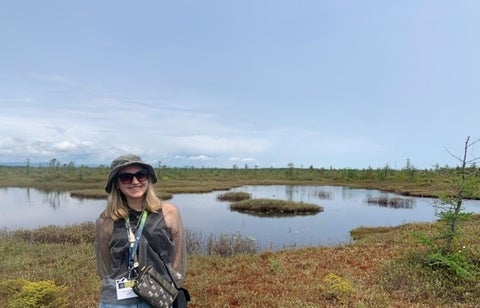I had the opportunity to attend the RE3 Conference in early June in Quebec City, as well as the associated Can-Peat/GPI workshop. The Can-Peat/GPI workshop began with site visits to Saint-Henri bog, a harvested peatland in various states of restoration (5 years and 10 years post restoration. There were also examples of sites that utilized various restoration techniques, such as the moss-layer transfer technique, rewetting, and a donor site. There was even a demonstration for the moss-layer transfer technique, as well as a discussion on the steps for restoring a peatland, and details surrounding sustainable peat harvest. The second bog site was at Grand Plee Bleue, a pristine ombrotrophic bog (pictured). At both the restored and pristine sites typical peatland plants were observed, such as Sphagnum moss species, sundews, pitcher plants, and even pink lady slipper orchids in full bloom. The field trip provided great context for the sessions, both in the Can-Peat workshop and the RE3 conference. The two-day Can-Peat/GPI workshop hosted several sessions regarding peatland policy, science, restoration, and data gaps. There was also an informative breakout group discussion in which experts highlighted which peatland characteristics were important for their research. After this, the group ranked the importance of the different characteristics for their own research, and a group discussion followed. One article that was highlighted was the recent Global Peatlands Assessment by the United Nations and Global Peatlands Initiative.

The remainder of the conference hosted numerous sessions on peatland rewilding, reclamation, and restoration. Each keynote speaker highlighted different aspects of working in restoration from their perspectives. The Can-Peat session highlighted multiple student projects, as well as the overarching goals of the project, with space for commentary on behalf of the peatland experts attending the conference. There were also two evening poster sessions, which featured submissions from government, industry, and students. I had the opportunity to present my undergraduate thesis project as a poster. I was able to discuss my findings with experts and even meet those who had written the papers that paved the way for my research. The organizers prepared numerous evening activities and mid-conference field trips. One of which was whale watching in Tadoussac, on the St. Lawrence River, where several types of whales frequent. We were fortunate enough to see a whole pod of beluga whales and even one baby beluga as we entered the Saguenay Fjord. The landscape in the fjord was incredible with the tall rocks on the sides and small waterfalls that could be missed if not paying close attention. Overall, the conference and Can-Peat workshop was an incredible first conference experience, with the chance to meet people studying in the same field, get out into nature, explore the beautiful Quebec City and surrounding areas, make connections for data sharing, and present my research.